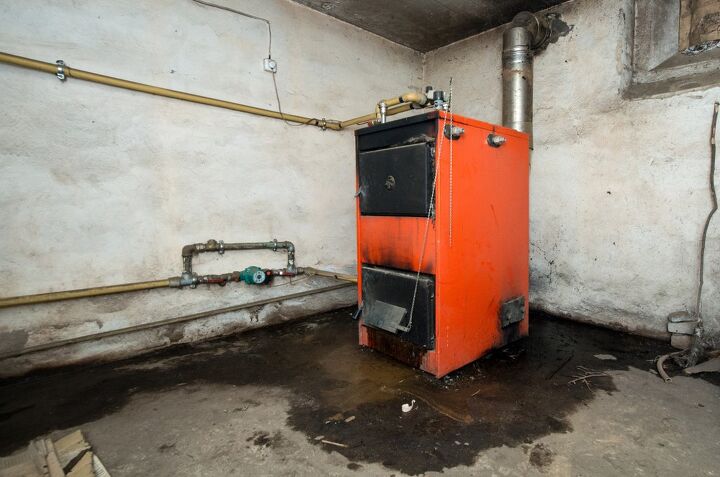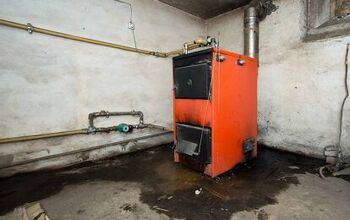How Efficient Is A 20 Year Old Furnace?

Your furnace is an important part of your central heating system. It keeps your house warm in the winter, but what happens when your furnace starts to age?
A 20-year-old furnace is only 60% effective, and it will waste 40% of its heat and energy. The average furnace lasts for 10-20 years, and it steadily declines after 10 years. A new furnace can generate heat with 95% efficiency and save you hundreds per year.
Old furnaces were built to last, but have lower fuel efficiency than new ones. How do you know when it’s time to throw out the old and invest in a new furnace? You can begin by checking your current furnace to see if it’s still doing its job.
Do You Need a Heating and Cooling Contractor?
Get free, zero-commitment quotes from pro contractors near you.

How to Gauge the Efficiency of Your Furnace
There are a few ways to tell that your furnace is at the end of its life. If your gas bill is significantly higher than usual, that’s probably a sign that your furnace isn’t working as it should. This is a result of your furnace running longer and harder to compensate for lost heat.
If you’re calling a repairman every few months, that’s not a good sign. Your furnace should only need regular maintenance like any other appliance. If its pieces and parts need constant attention, that’s a sign it’s time for a new furnace.
Uneven heat and cooling in your house is also a sign that your furnace isn’t doing its job right. If you find rooms warmer or colder than other rooms, it might be time to call a heating professional to check actual temperatures to see where heat is actually reaching.
Signs You Need to Replace a Part And Not the Whole Furnace
If your furnace isn’t producing heat, there are a few things to check before deciding to replace it.
- Is your thermostat on? Make sure you set it to heat before assuming the worst!
- Check to see if you blew a fuse. This may have caused the furnace to go out.
- Change your air filter. A clogged or dirty air filter can have a negative impact on your furnace’s operations.
- Make sure your furnace and the area around it are clean.
- Clean your burner. Dust can easily accumulate when it isn’t in use.
- Oil the furnace blower.
- Check that your pilot light hasn’t blown out.
- Make sure the furnace is blowing air.
- Check the vents for blockage.
Signs You Should Replace Your 20-Year-Old Furnace
Most furnaces only have a lifespan of 15-20 years, so your 20-year-old furnace is probably on its way out.
If your burner flame turns yellow, that means it’s time to get a replacement furnace. This is a safety issue for your house because the furnace is now producing carbon monoxide. Call a professional ASAP to have this problem resolved immediately!
If it sounds like you’ve got a ghost in your house, don’t worry! It’s just another sign to replace your old furnace. Buzzing and rattling are indications that your furnace has developed cracks or leaks and needs to be replaced.
If you’ve turned the heat up all the way and it’s still cold, it’s time for a new furnace. Old furnaces lose efficiency as they age, wasting heat (and your money). A cold house is a clear sign that your furnace isn’t working as it should.
Furnaces pump dry air into your home and reduce humidity. However, when furnaces get older, they substantially dry out the air in your home.
This can pose a problem in the winter when it’s important to have 30-40% humidity in your home. Proper humidity levels help keep you comfortable. A new furnace can help with just that!
An old furnace can also produce less clean air than a new furnace. If you notice dustier air, that’s a sign your furnace isn’t working as well as it used to. Older models don’t have the high-quality airflow and filtration systems that new ones do.
Benefits of a New Furnace
If your furnace is rattling, not heating the house, or the burner flame has turned yellow, prepare for the worst. These are all tell-tale signs that your furnace is past its prime, and it’s time to buy a new one.
Here are a few reasons you might want to consider purchasing a new furnace:
- A new furnace will be more energy efficient than your previous one. Your newer model will likely be about 95% efficient. This means it will generate about 5% of waste, which will save you a lot of money in the winter.
- Your new furnace will help with the uneven heating caused by your old one. With its higher efficiency and low waste, it can more evenly heat your house.
- No more rattling and unpleasant noises!
- It’s safer than your old one. The risk of carbon monoxide production is much lower.
What Are the Costs of a New Furnace?
The average cost of a natural gas furnace is between $2,250 and $3,800. The more expensive the unit, the more efficient.
It will be rather expensive to replace your old furnace, but your gas bill will be lower. The higher upfront cost will benefit you in the long run due to higher efficiency rates.
Things to Consider When Buying a New Furnace
When buying a new furnace, there are many things to consider to find the right one for your home:
- Make sure it’s the right size! A professional installer can recommend the appropriate size furnace for your home.
- Make sure to consider the efficiency of the furnace; the more efficient the system, the lower your energy costs!
- Weigh the benefits of the different types of fuel. Some are cheaper to install, but pricier in the long run. Others may not even be available in your region!
- Prices. Make sure to consider both the installation costs and the cost of the furnace.
- Consider whether or not you want a warranty on your unit and its parts.
- Think about your climate and region; some regions only offer certain fuel types.
Related Questions
How do you measure the efficiency of a furnace?
Furnace efficiency is measured in terms of AFUE, or annual fuel utilization efficiency. The higher the percentage rating of a furnace, the more fuel it is turning into usable heat. AFUE usually falls between 30 and 100, and numbers lower than 30 are definitely not desireable.
How often should you have your furnace inspected?
Having your furnace inspected each year will help extend its life and efficiency. Have your unit inspected before the winter so you’re not hit with unexpected surprises when you need your furnace the most.
What are the different types of furnaces?
There are four different types of furnaces: natural gas, oil, electric, and propane.
Natural gas furnaces are the most popular type of furnace in America. They provide the most bang for your buck and can be 98% efficient.
Oil furnaces are a bit less popular and a bit less efficient. However, they cost less to install than their natural gas counterparts.
Electric furnaces are the cheapest of all four options. They can last on average ten years longer than natural gas furnaces. However, your monthly bill will be significantly higher.
Propane is easily stored in tanks for furnace use. It tends to be available in areas where oil and gas are not. It is the least common furnace type.
What are the most popular furnace brands?
The most popular furnace brands are Trane, Carrier, American Standard, Rheem, and Goodman. Trane offers both gas and oil furnaces. Carrier offers all four types.
American Standard only offers gas. Rheem offers all four. Goodman offers gas, electric, and propane and is the most budget-friendly option.
Do You Need a Heating and Cooling Contractor?
Get free, zero-commitment quotes from pro contractors near you.

Wrapping Up
Heating your home in the winter is of the utmost importance, especially in cold climates. An inefficient furnace won’t heat like it’s supposed to. 20-year-old furnaces tend to be around 60% efficient whereas their younger counterparts can be up to 95% efficient.
It is time to replace your furnace if it’s rattling, unevenly heating your home, or emitting carbon monoxide. Usually, these issues befall older models since furnaces have a lifespan of 15-20 years.
When buying a new furnace, you should consider brands, prices, fuel types, and sizing. This is a surefire way to have a cozy, warm home in the winter.

Stacy Randall is a wife, mother, and freelance writer from NOLA that has always had a love for DIY projects, home organization, and making spaces beautiful. Together with her husband, she has been spending the last several years lovingly renovating her grandparent's former home, making it their own and learning a lot about life along the way.
More by Stacy Randall



























